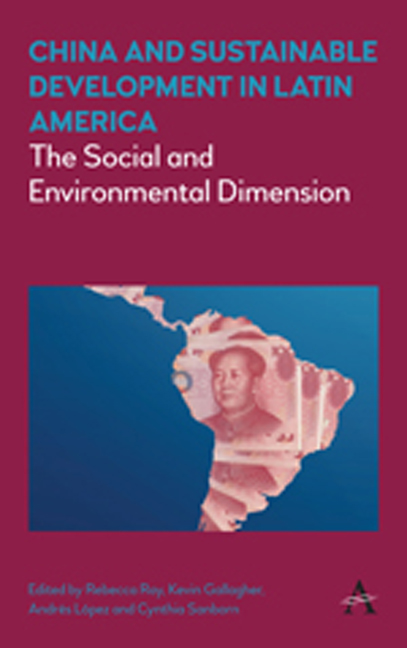Book contents
- Frontmatter
- Contents
- List of Illustrations
- Acknowledgments
- Part I INTRODUCTION AND REGIONAL OVERVIEW
- Part II CHINA'S AND LATIN AMERICA'S HYDROCARBONS SECTORS
- Part III CHINA'S AND LATIN AMERICA'S MINING SECTORS
- Part IV CHINA'S AND LATIN AMERICA'S AGRICULTURAL SECTORS
- Part V CHINA'S AND LATIN AMERICA'S MANUFACTURING SECTORS
- Chapter 8 Chinese Incidence on the Chilean Solar Power Sector
- Chapter 9 China in Mexico: Some Environmental and Employment Decisions
- Notes on Contributors
- Index
Chapter 9 - China in Mexico: Some Environmental and Employment Decisions
from Part V - CHINA'S AND LATIN AMERICA'S MANUFACTURING SECTORS
Published online by Cambridge University Press: 12 September 2017
- Frontmatter
- Contents
- List of Illustrations
- Acknowledgments
- Part I INTRODUCTION AND REGIONAL OVERVIEW
- Part II CHINA'S AND LATIN AMERICA'S HYDROCARBONS SECTORS
- Part III CHINA'S AND LATIN AMERICA'S MINING SECTORS
- Part IV CHINA'S AND LATIN AMERICA'S AGRICULTURAL SECTORS
- Part V CHINA'S AND LATIN AMERICA'S MANUFACTURING SECTORS
- Chapter 8 Chinese Incidence on the Chilean Solar Power Sector
- Chapter 9 China in Mexico: Some Environmental and Employment Decisions
- Notes on Contributors
- Index
Summary
This chapter explores the unique characteristics of Mexico's trade with China and investment from China, especially for Mexico's manufacturing sector. In addition, we examine the environmental and social characteristics of these flows, looking specifically at greenhouse gas (GHG) emissions and employment- related impacts for Mexico. Finally, we perform a case study of a Chinese company doing business in Mexico's manufacturing industry.
Mexico is unique relative to the other studies in this project. Mexico has indeed experienced a surge in exports to China, but these still remain very modest as compared to the great flow of imports from China. This phenomenon reflects Mexico's difficulties in competing in the manufacturing sector with China, both at home and abroad, and its still incipient primary goods exports to that country. Moreover, Mexico has thus far not received as extensive foreign direct investment from China as compared to the other countries in the region.
GHG caused by Mexico's exports to China are increasing much faster than Mexico's GHG generated by its total exports. Though there has been some offsetting of these emissions because of technological changes in Mexican export to China in several sectors, the change in export structure toward more polluting sectors (including primary sectors), together with the high rate of growth of these exports, explain this tendency. When looking into manufacturing exports from Mexico to China, the structure or composition effect favors lesspolluting sectors, so this has a somewhat compensating effect together with the technology effect. This shows up in our statistical analysis, and in our case study we find a serious effort by a Chinese enterprise to comply with Mexican environmental regulations. Regarding employment, Mexican manufacturing firms, particularly in the textiles and apparel sector, have shed jobs due to competition with China. However, technical innovation in several sectors where there is competition with China has also had an important role in these job losses, especially in more recent years.
- Type
- Chapter
- Information
- China and Sustainable Development in Latin AmericaThe Social and Environmental Dimension, pp. 321 - 354Publisher: Anthem PressPrint publication year: 2017

